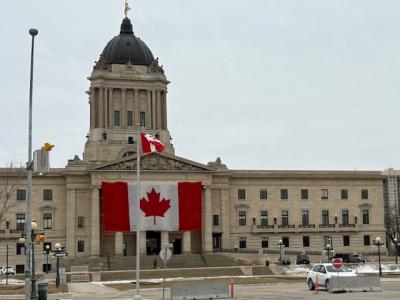Even as it begins to hit some political turbulence, Wab Kinew and Manitoba’s NDP government continue to soar in popularity, a new Probe Research poll for the Winnipeg Free Press finds.
During the past three months, NDP support in Manitoba has risen to its highest level yet (56%, up from 51% in June). Support for the Progressive Conservatives (PCs) decreased slightly during that period (from 38% in June to 34% today), with provincial Liberal support also continuing to slip as this party also seeks a new leader (4%, down from 6% in June).
The Keystone Party currently has three per cent support (+2% vs. March), with the Greens and other parties accounting for the remaining two per cent of support among decided and leaning Manitoba voters.
Overall, 13 per cent of Manitobans are undecided.
NDP support remains especially high in Winnipeg, but the party now leads the PCs in their traditional stronghold of rural Manitoba. NDP support has increased eight points outside the Perimeter since March (48%, up from 40%), with the PCs dropping to 43 per cent (vs. 52% in March). A small amount of PC support in rural Manitoba appears to have moved to the Keystone Party, which currently sits in third place – ahead of the Liberals.
Within Winnipeg, the NDP has slightly increased its already commanding lead (61%, up from 59% in March), while PC support remains at 29 per cent for the third straight wave. Only six per cent of urban voters would now cast ballots for a provincial Liberal candidate (-3% vs. March and -9% since the October 2023 election). NDP support is very consistent throughout Winnipeg neighbourhoods.
In addition to holding a commanding lead among female voters, the two parties are tied in support among men. The NDP remains much more popular than the PCs among most other demographic categories, including older voters and racialized residents.
NDP support appears to be closely correlated to Premier Wab Kinew’s personal popularity among citizens. Overall, two-thirds of Manitobans strongly or somewhat approve of his job performance, compared to one-third who approve of the work PC interim leader Wayne Ewasko is doing and three in ten who approve of interim Liberal leader Cindy Lamoureux. Kinew’s popularity is widespread. Even four in ten PC supporters indicate the current premier is doing a good job.
When Manitobans are asked to choose which word best describes how they feel about the NDP government and its accomplishments to date, most pick positive words, including three in ten who say they are satisfied, 12 per cent who are happy and 15 per cent who are enthusiastic. Only one in five gravitate to negative words, with most of these indicating they are disappointed and a small number expressing anger. One in five are indifferent about the work the NDP has done so far.
The Story
Despite dealing with some policy-related and internal political challenges during the past few weeks, the NDP continues to soar well above the Progressive Conservatives and Liberals – both of whom are fronted by interim leaders who are little known to Manitobans. Wab Kinew’s personal brand appears to be resonating very well with Manitobans, and the NDP government remains firmly entrenched in its honeymoon phase.
While the political environment will certainly become more challenging as time goes on, the NDP’s popularity continues to increase nearly one year after taking office. This speaks to its leader’s ability to generate goodwill among Manitobans of all different backgrounds – including groups that do not traditionally vote NDP, including men, older Manitobans and rural residents.
Disclosure Statement
Probe Research is a member of the Canadian Research Insights Council (CRIC) and confirms that this research fully complies with all CRIC Standards including the CRIC Public Opinion Research Standards and Disclosure Requirements. Learn more at: https://www.canadianresearchinsightscouncil.ca/standards/por/
Methodology
Probe Research surveyed a random and representative sampling of 1,000 adults residing in Manitoba between September 5th and 15th, 2024.
With a sample of 1,000, one can say with 95 per cent certainty that the results are within ± 3.1 percentage points of what they would have been if the entire adult population of Manitoba had been surveyed. The margin of error is higher within each of the survey’s population sub-groups.
The sample consists of 465 Manitobans randomly recruited via live-agent operator, 311 randomly recruited via Interactive Voice Response (IVR) and 224 members of Probe Research’s online panel. All respondents completed the survey on an online platform.
Modified random digit dialing, including both landline and wireless numbers, ensured all Manitoba adults had an equal opportunity to participate in this Probe Research survey.
Minor statistical weighting has been applied to this sample so that age, gender and regional characteristics properly reflect the province’s population.



